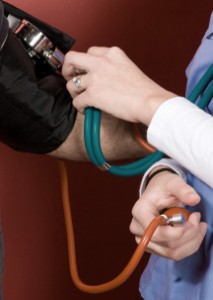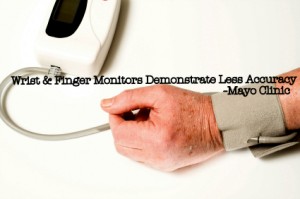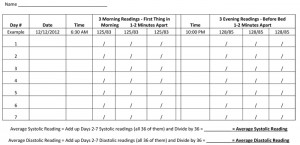In case you were wondering, many people with high blood pressure are trying to figure out how to effectively achieve accurate blood pressure readings. As a matter of fact, there are many studies and reports on this issue since many people struggle with this. Once you know what steps to take to assure yourself the most accurate readings, it’s very simple.
We decided to help out and get you on the right track, by putting together the following summary of various reports and studies that provide dos and don’ts for accurate blood pressure readings.
Getting Started, Always Keep in Mind:
1) Daily Fluctuations are Normal. Normal and good blood pressure readings will fluctuate throughout the day and can change by ≥20 mm Hg between readings. Readings are easily influenced by many physiological factors. So, doctors generally recommend that you should not be overly concerned if you see such differences during the day and always remind yourself of this fact.
2) Home Monitoring is Most Effective. Readings have proven more accurate at home than at the doctor’s office. Most patients have heightened anxiety when they are at the doctor’s office causing higher blood pressure readings than when quietly at home. This phenomenon is known as “white-coat hypertension” and is common. There are other theories as to why people feel more anxious during a visit to the doctor. Besides increased readings causing patients frustration and anxiety, they may also cause doctors to order stronger medications than necessary. Many doctors, therefore, urge their patients to use home blood pressure monitors. While it is best to monitor your blood pressure at home, it’s important to follow the right technique to achieve accurate results.
If you prefer having your doctor take your reading, then it is still advisable to follow the tips listed here. However, you should take one extra step and arrive at your doctor’s office at least 15 minute prior to your appointment to give yourself time to relax. If you were not able to get their early, no problem, ask your doctor for about 5 minutes to relax. Your doctor will understand the importance of easing into a blood pressure test. Keep in mind, that reports show that, walking fast increases your reading by 5 to 14 points and driving in traffic can raise it 9 to 14 points. So insist, if you have to, to rest before your blood pressure test.
The Big No No’s:
Studies demonstrate that the leading reason why people are not able to achieve accurate at home blood pressure readings are because they:
1) Measure Their Blood Pressure TOO Frequently. People become obsessed with taking their blood pressure readings causing over estimations. It is inevitable that you will have high readings among all your readings. By increasing the number of times you take a reading, you also increase your chances of high readings. Such high readings can make you anxious and in effect increase our blood pressure, creating a vicious cycle. Bottom line, over doing it can have the opposite effect and increase your hypertension. Below you will find information about how often you should take a reading.
2) Using Wrist or Finger Blood Pressure Monitors. “The American Heart Association recommends only models with a cuff that goes around your arm, not the wrist or finger models.” The arm devices are the most reliable and have the additional advantage that they measure pressure in the same artery that has been used in all the large studies of high BP and its consequences.
3) Using the Wrong Cuff Size. Use of a cuff that is too large, too small, or improperly wrapped can lead to inaccurate blood pressure readings. If the cuff is too narrow you risk falsely high blood pressure values. When the cuff is too wide you risk falsely low values. “The ratio of the width of the cuff to the circumference of the extremity is of critical importance for accurate blood pressure measurements. According to the American Heart Association, the width of the compression cavity of the cuff should be equal to 40% of the circumference or 1.2 times the diameter of the extremity to achieve accurate readings.” Each patient’s extremity should be properly measured to determine the most appropriate cuff size.
4) Jumping Right Into It. People tend to rush to strap on their blood pressure monitor and quickly get their daily reading. Well, it’s not the way to go about getting an accurate reading. Like everything in life, patience is the most effective way to achieve your goals. When you get home, make time to sit down quietly for a few moments before taking a reading.
5) Stress at Home. Do you have a busy home life? Lots of kids or grandchildren running around? Maybe your neighbor is in the middle of renovations? Things are tense at home? It’s normal to not always feel relaxed at home and studies show that unusual circumstances can make you anxious causing a spike in your blood pressure readings. It is important to find a place where you are relaxed before taking a reading. Maybe during such tense moments, you feel more at ease in your office? At a friends house? If that is the case, consider taking your blood pressure monitor to work.
The General Do’s:
1) Check Your Home Monitor With Your Doctor. “Take your monitor to your next doctor’s visit to verify that it’s measuring accurately by comparing it to the doctor’s monitor. After that initial review, check its accuracy once a year at your doctor’s office.
2) No Caffeine. Do not drink coffee, tea, cola or other types of caffeinated drinks 30 minutes before taking a reading.
3) No Smoke or Exercise. Do not smoke or exercise within 30 minutes before taking a reading.
4) Bathroom Break. Go to the bathroom before taking a reading – a full bladder is uncomfortable and can therefore; boost your blood pressure.
5) Use an Automatic, NOT Manual Monitor. Most devices specifically designed for use by patients at home are fully automatic, so that the patient only needs to wrap the cuff around the upper arm and press a button for the machine to take the blood pressure readings and display the values for systolic and diastolic pressure on a screen.
6) Check Your Blood Pressure on Each Arm, Consistently. Some reports advise that you take your blood pressure on one arm and do so consistently. Usually, it is recommended to use your left arm since the blood pressure standards were set from readings taken from left arms.
There is another school of thought that suggests that consistently checking both right and left arms can catch problems you might miss. For example, if the only blood pressure measurement taken happens to be on your “low pressure” side, differences between your two arms of 15 points or more can be an early-warning sign of a clogged aorta or blockage in another major blood vessel.
7) Position Your Arm at Heart Level. Support your arm on a flat surface so that the upper arm is supported at the level of the heart. This is advised because the standards for normal blood pressure were set based on measurements taken from people while in this position. To assure accuracy and to effectively compare your readings to the standards, it is important to imitate the positions used to set the standards.
8) Assure Yourself Physical Comfort. Your back should be supported, both feet should be flat on the floor and legs uncrossed. These steps can prevent a 2- to 11-point increase in blood pressure readings.
9) Relax Before Starting. After you put the cuff on, sit and relax for a few minutes before checking blood pressure, and place you feet on the floor comfortably.
10) Confirm Your Readings. Take 2-3 readings rather than just one, 1-2 minutes apart, writing each one down using a Blood Pressure Chart for Monitoring Blood Pressure at Home. It’s advised to NOT take more than three readings.
11) Record Readings. Keep a chart of all your readings for yourself and for your next doctor visit. The chart below is a great sample chart that you can create for yourself. You can find a great sample of such a chart below and you can download it from The Natural Health Advisory.
12) Two Sets of Readings Per week. Check no more than twice a week except in these cases:
- Your hypertension is severe
- You’re changing medications
13) Check Randomly and During Ordinary Times. Don’t check your blood pressure only when you think your blood pressure readings will be good or only when you think they will be high; check at randomly and during ordinary times.
Initial Estimate Dos:
The steps you should take when you start to take your initial blood pressure readings:
1) Week One. Take 3 morning and 3 evening readings every day for 1 week. The morning readings should be taken first thing in the morning before taking any medication, and the evening readings should be taken before bed. After each reading, record the numbers in your chart. See the chart below for a great sample.
2) Discard the readings of the first day.
3) Calculate Your Average. Then calculate the average systolic (upper) and average diastolic (lower) values for all your blood pressure readings for the remaining six days. If you took 3 readings each morning and another 3 each evening, you should have a total of 36 readings on which to make decisions about diagnosis and treatment.
4) Talk to Your Doctor. Report to your doctor the results and discuss with your doctor the various options you have to lower your blood pressure. Discuss with you doctor everything including, natural solution, lifestyle changes, food, exercise and possible medications. Do not forget to discuss with your doctor the various side effects of possible medications.
Learn more from our sources:




 (2 votes, average: 4.50 out of 5)
(2 votes, average: 4.50 out of 5)
As I pointed out the other day, the reasoning behind item 7 is not just because that’s how all the studies were done. You position the arm so that the sensor is at mid-heart level in order to avoid a hydrostatic artifact. That was the original reason all of the studies were done this way, as experts in fluid mechanics pointed this out to cardiologists. The hydrostatic issue involves a ‘column of water’ or in this case blood. Same difference since the density is about the same. When the sensor is above mid-heart, the reading is artificially low. When the sensor is below mid-heart, it’s too high. This is due to the ‘column of blood’ that adds a gravitational force to the reading when the sensor is too low. Vice-versa when too high.
Thank you for explaining how often to check BP. I was sometimes checking twice or more times a day if I thought a reading was too high or low. I suffer from anxiety and was literally driving myself crazy checking too often. I think I was making my BP worse. Thanks again for your explanation.
We are happy to hear that the summary of diverse reports and studies on how best to achieve accurate BP readings was helpful to you.
My doctor experience has been that if I have high readings in their office, they think I have high readings at many other places. They don’t care what my readings are at home. And since I don’t have weight to lose, they don’t see me getting too much benefit from lifestyle changes. When I have taken 5mg and less of Lisinopril, I think my BP goes too low at home. They say it can’t go too low, that I would pass out vs induce a heart event. Please show some studies on what can happen if blood pressure goes too low while awake and sleeping.
I have had the same experience as DM with doctors! And I agree with her that we need more information on being over-medicated because doctors will consider only their office readings.
Sensible and timely article.
One of the to-do comments (number 8?) stated importance of being physically comfortable (seems sensible), but included in that having back supported. I’ve read (somewhere over the last, say, 6 months – maybe in Prevention magazine?) that it’s important to sit up straight with back vertical – blood pressure increases when one leans back.